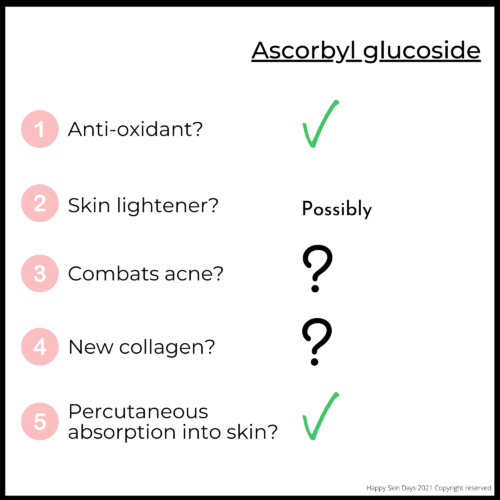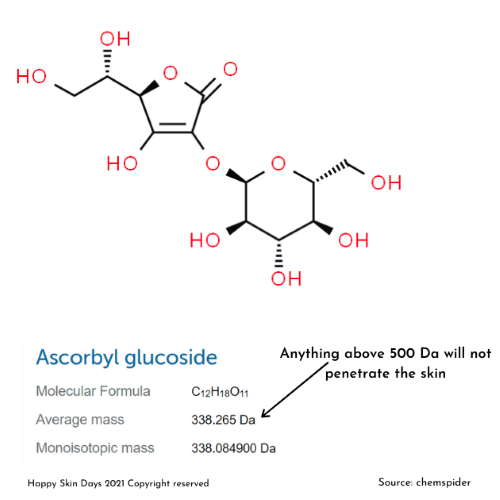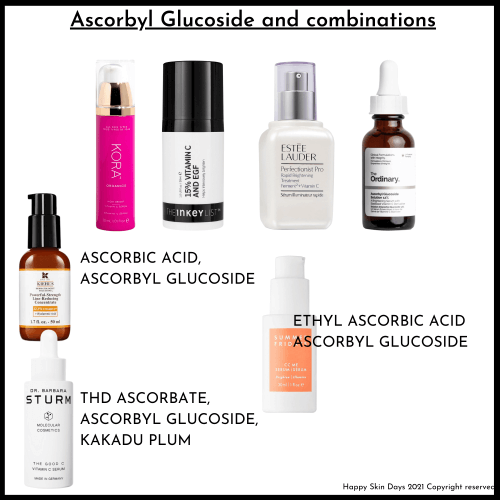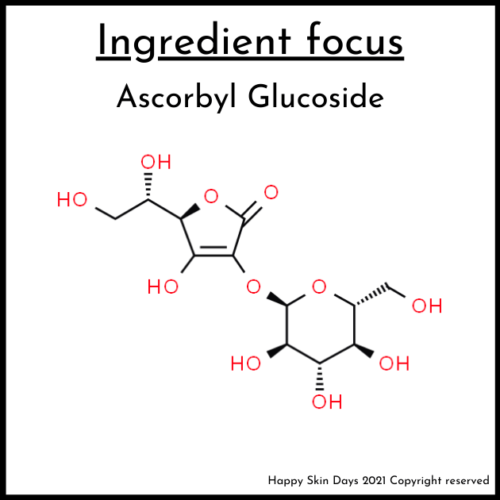In today’s blog, I am doing a deep-dive into Ascorbyl Glucoside, but before that, this is my 50,000 feet view of Ascorbyl Glucoside as an ingredient.

pH dependence
This quote is straight from the Cosmetic Ingredient Review (CIR) and demonstrates that Ascorbyl Glucoside, despite being a water soluble Vitamin C derivative can be stable in cosmetics. The quote is: “Optimal condition of retaining Ascorbyl Glucoside with high stability in cosmetics has been 55 C and pH 6.4.” In general, the pH of common cosmetic products is between 5.5 and 7.
1) Chemical structure

2) Products containing Ascorbyl glucoside
Industry survey data collated by the CIR (American body) indicates that Ascorbyl Glucoside is found to a maximum of 5% in leave-on products. In the EU, there are no such restrictions.

3) What characteristics of Vitamin C (L-Ascorbic Acid) do we want Ascorbyl Glucoside to replicate?
“The chemically active form of the ascorbic acid used in medical practice is L-ascorbic acid (LAA) (Ravetti et al).” This compound achieves the following:
- its essential for the synthesis of new collagen in the dermis. Topical application of L-Ascorbic Acid has been demonstrated to produce new collagen in the dermis.
- it is a skin lightener, as it interferes with the enzymatic activity of tyrosinase, an enzyme that is vital for the production of the pigment (melanin) that in turn, gives skin its colour
- is a potent anti-oxidant and has been demonstrated to reduce reactive oxygen species on exposure to UV radiation as well as reduce subsequent photodamage.
4) How does Ascorbyl Glucoside stack up?
I will be very honest: out of all the Vitamin C derivatives I have looked at so far (THD Ascorbate, SAP, MAP and Ascorbate tetraisopalmitoyl), the data/clinical trials/research on Ascorbyl Glucoside is the “flimsiest.”
Flimsy is a British English slang word which I use to mean unconvincing.
These are the features about Ascorbyl Glucoside that I am confident about:
- in the USA, the maximum amount it is used in leave-on products is typically 5%
- it is a water soluble Vitamin C derivative
- its an anti-oxidant and therefore acts as a free-radical scavenger reducing the impact of UVB photodamage.
- Does have a photoprotective effect against UVB-induced damage in human epithelial cells (as demonstrated in a lab by Yanagida et al). Maeda J et al have expanded this analysis to include UVC (which is fine, except UVC is absorbed by the stratosphere and does not reach the earth’s surface).
- it is absorbed by the epidermis and does appear to be converted into Ascorbic Acid
I remain unconvinced that it is a potent skin lightener (or a skin bleaching agent) and/or that it causes the formation of new collagen in the dermis (skin). This is my personal view based on what I believe is a lack of a comprehensive clinical trial on this particular issue.
5) What studies/clinical trials etc have I found?
I am going to briefly outline the studies I have found, but honestly apart from an updated review by the Cosmetic Ingredient Review body, these studies/trials are severely lacking in persuading me that Ascorbyl Glucoside is a serious skin lightener or causes new collage formation in the skin.
there is percutaneous absorption of Ascorbyl Glucoside
Kumano Y et al, applied two creams containing 2% Ascorbyl Glucoside to the legs of five female Japanese men and the areas to which the test creams were applied were covered with cling film and a bandage was applied on top. In the micrographs of the skin treated with cream, small black silver particles indicated the presence of Ascorbic Acid in the skin.
Kumano Y et al found that silver particles were observed between epidermal cells for as long as three days. The authors noted that the results indicate Ascorbyl Glucoside releases Ascorbic Acid in the skin. Such silver particles were not observed in creams that did not contain the Ascorbic Acid derivative.
(Naturally, no one applies face cream and applies cling film for 14 hours afterwards and also the utility of this study is severely limited because its just 5 men. For a study to be taken seriously, there should be at least 21 participants).
successfully treats melasma and postinflammatory hyperpigmentation
(I sometimes think, that the heading of clinical trials is so optimistic because I automatically think I can apply this to my situation. This is not accurate at all, as demonstrated by Taylor MB et al).
Taylor MB et al performed a full-face iontophersis treatment (basically pushes product into your skin using a form of vibration), with full-up 12-24 at home treatments over 1-2 months for 35 patients. Also, the patients were required to use mandelic/malic acid (exfoliating acid regime), use sunscreen and engage in sun-avoidance behaviour.
(So this is not something that you and I could do at home)
There was a statistically significant improvement in abnormal pigmentation.
collagen synthesis in a lab can be stimulated via Ascorbyl Glucoside.
Yamaotot use a lab culture of cells to demonstrate that Ascorbyl Glucoside is,”gradually cleaved by the cellular alpha-glucosidase to release L-ascorbic acid, which adequately stimulates collagen synthesis and proliferation of human skin fibroblasts.”
This study is of such limited utility, I feel as if I am wasting my life criticizing it, so I won’t.
6) What do manufacturers suggest?
Notably most of the manufacturers on Ultroprospector, a paid subscription service, for Ascorbyl Glucoside are based in Asia. This only supports the trend of skin whitening being a big deal in Asia.
This is the marketing data from one particular manufacturer and I will point your attention to all the disclaimers published by the manufacturer at p4.
This blog was last updated in the week ending Friday 6th August 2021 and unless otherwise stated, it will not be updated again.
See also
Sources and uses
Safety Assessment of Ascorbyl Glucoside and Sodium Ascorbyl Glucoside as Used in Cosmetics (Draft final report for panel review (Aug 21 2020)
Liu, Y., Liu, C., & Li, J. (2020). Comparison of Vitamin C and Its Derivative Antioxidant Activity: Evaluated by Using Density Functional Theory. ACS omega, 5(39), 25467–25475.
Hsiao CY, Huang CH, Hu S, Ko YS, Sung HC, Chen CC, Huang SY. Fractional carbon dioxide laser treatment to enhance skin permeation of ascorbic acid 2-glucoside with minimal skin disruption. Dermatol Surg. 2012 Aug;38(8):1284-93.
Hikima T, Tamura Y, Yamawaki Y, Yamamoto M, Tojo K. Skin accumulation and penetration of a hydrophilic compound by a novel gemini surfactant, sodium dilauramidoglutamide lysine. Int J Pharm. 2013 Feb 25;443(1-2):288-92
Kumano Y, Sakamoto T, Egawa M, Iwai I, Tanaka M, Yamamoto I. In vitro and in vivo prolonged biological activities of novel vitamin C derivative, 2-O-alpha-D-glucopyranosyl-L-ascorbic acid (AA-2G), in cosmetic fields. J Nutr Sci Vitaminol (Tokyo). 1998 Jun;44(3):345-59
Nakamura S, Oku T. Bioavailability of 2-O-alpha-D-glucopyranosyl-L-ascorbic acid as ascorbic acid in healthy humans. Nutrition. 2009 Jun;25(6):686-91
Yasuda S, Tada M, Yamada K, Takahata K. Suppressive effects of ascorbate derivatives on ultraviolet-B-induced injury in HaCaT human keratinocytes. In Vitro Cell Dev Biol Anim. 2004 Mar-Apr;40(3-4):71-3.
Yamamoto I, Muto N, Murakami K, Akiyama J. Collagen synthesis in human skin fibroblasts is stimulated by a stable form of ascorbate, 2-O-alpha-D-glucopyranosyl-L-ascorbic acid. J Nutr. 1992 Apr;122(4):871-7.
Taylor MB, Yanaki JS, Draper DO, Shurtz JC, Coglianese M Successful short-term and long-term treatment of melasma and postinflammatory hyperpigmentation using vitamin C with a full-face iontophoresis mask and a mandelic/malic acid skin care regimen.Journal of Drugs in Dermatology : JDD, 01 Jan 2013, 12(1):45-50
Maeda J, Allum AJ, Mussallem JT, Froning CE, Haskins AH, Buckner MA, Miller CD, Kato TA. Ascorbic Acid 2-Glucoside Pretreatment Protects Cells from Ionizing Radiation, UVC, and Short Wavelength of UVB. Genes (Basel). 2020 Feb 25;11(3):238. doi: 10.3390/genes11030238. PMID: 32106443; PMCID: PMC7140853.
Miyai E, Yanagida M, Akiyama J, Yamamoto I. Ascorbic acid 2-O-alpha-glucoside, a stable form of ascorbic acid, rescues human keratinocyte cell line, SCC, from cytotoxicity of ultraviolet light B. Biol Pharm Bull. 1996 Jul;19(7):984-7.
Elmore AR. Final report of the safety assessment of L-Ascorbic Acid, Calcium Ascorbate, Magnesium Ascorbate, Magnesium Ascorbyl Phosphate, Sodium Ascorbate, and Sodium Ascorbyl Phosphate as used in cosmetics. Int J Toxicol. 2005;24 Suppl 2:51-111.
